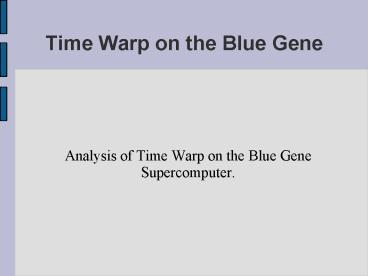Time Warp on the Blue Gene PowerPoint PPT Presentation
1 / 16
Title: Time Warp on the Blue Gene
1
Time Warp on the Blue Gene
- Analysis of Time Warp on the Blue Gene
Supercomputer.
2
Overview
- Port the ROSS kernel from shared memory to the
Blue Gene/L - Compare the performance of ROSS-MPI with ROSS-SMP
on a shared memory platform - Investigate the performance of ROSS-MPI on the
Blue Gene/L
3
Motivation
- Distributed memory computers, scale bigger than
shared memory computers. - Models exist that are beyond the capability of
shared memory computers. - The Internet contains 500,000,000 host ISC,
modelling the Internet on shared memory often
requires compromises in model design.
4
Background
- Time Warp is an optimistic parallel discrete
event simulator. - ROSS is an efficient Time Warp implementation.
- Blue Gene/L is a distributed memory
supercomputer, capable of 500 TFLOPS.
5
TimeWarp Architecture, Recap
- Logical Processor (LP) are tasks, the basic unit
of work. - Processor Elements (PE) are mapped to processors.
- Global Virtual time indicates the earliest time
for an event within the system. - Events older than GVT can be removed from memory.
- Events that execute out of order can be rolled
back.
6
Approach
- Implement the Processor Elements PE as separate
MPI tasks. - Split or remove global data structures.
- Replace Fujimoto with an efficient distributed
memory algorithm
7
Remote Events
- Process Elements (PE) are mapped to MPI tasks.
- Events between the Processor Elements are sent as
MPI messages, Remote events. - Remote events increase memory consumption.
- Remote events lead to ROSS-MPI consuming memory
during GVT computation.
8
GVT Computation algorithm
- Delivers the consistent cut, by performing a
global sum over the number of outstanding
messages. - Transient message problem avoided, as there are
no outstanding messages when it is computed. - Simultaneous reporting avoided, as GVT
computation is delayed until all messages are
received.
9
Workloads, PCS and PHOLD
- PHOLD, a synthetic benchmark that exercises the
performance of Time Warp. Workload is due to
event scheduling. Characterised by a random
communication pattern. - PCS, a model of a mobile phone network. An
example of a typical model.
10
Performance under SMP
11
Performance under SMP
- All events were randomly scheduled at another LP.
- ROSS-MPI's performance decreased with processor
count.
12
Performance under SMP
- Performance improvement is sub-linear with
increasing processor count.
13
PHOLD, Scaling
14
PHOLD,Scaling
- With a population of 8 million events, peak
performance of 300 million events/sec with 4096
processors. - With a population of 16 million events,
performance of 500 million events/sec with 8192
processors. - PHOLD modified, only 10 percent of events are
remote. - Results are preliminary.
15
Conclusion
- ROSS-MPI can simulate larger problems than
ROSS-SM. - ROSS-SM is noticeably faster than ROSS-MPI on
shared memory. - The scalability and performance of ROSS-MPI on
the Blue Gene/L is encouraging.
16
Summary
- Port the ROSS kernel to the Blue Gene/L
- Compare the performance of ROSS-MPI with ROSS-SMP
on a shared memory platform - Investigate the performance of ROSS-MPI on the
Blue Gene/L

